Home Decor
10 Stunning Brick Wall Accent Wall Ideas
Yearning for a design element that adds texture and charm to your space?
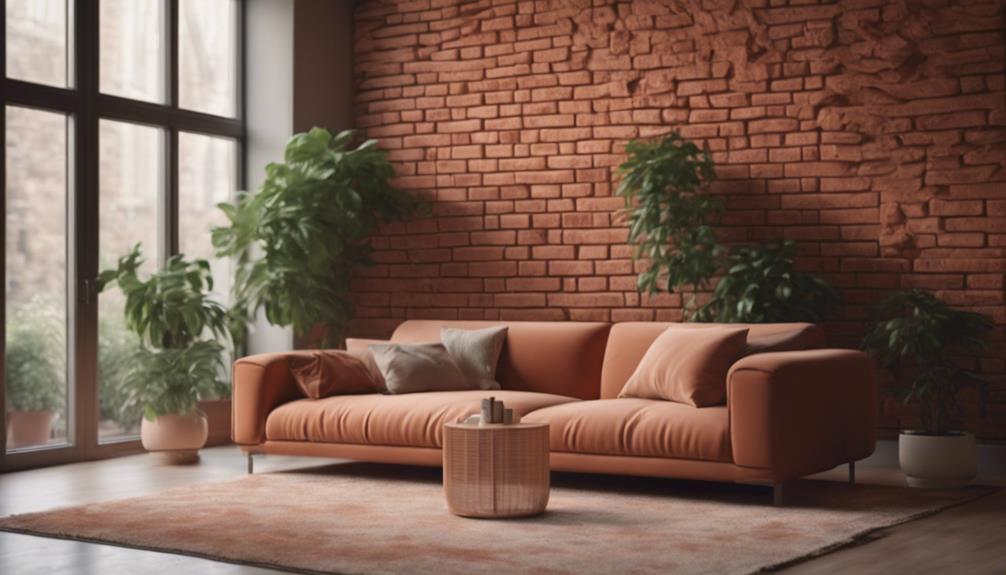
You're considering incorporating a stunning brick wall accent into your interior design. From exposed brick walls that add rustic charm to modern brick inlay designs that create visually appealing accents, there are numerous ways to inject texture, depth, and character into your space. Whitewashed brick walls can evoke a vintage-inspired charm, while industrial chic brick accent walls add a raw, urban vibe. Classic brick arch accent walls can elevate your space with timeless charm, and distressed brick accent walls can create a cozy, lived-in atmosphere. Each style offers a unique opportunity to make a statement – and there's more to discover as you explore the world of brick wall accent walls.
Key Takeaways
• Exposed brick accent walls inject rustic charm and industrial flair, elevating a room's character and creating a visual focal point.
• Rustic chic brick feature walls evoke warmth and character, adding a vintage charm and cozy focal point to a room.
• Modern brick inlay designs offer visually appealing accent walls with intricate designs that add depth and texture.
• Distressed brick accent walls add a weathered look charm to a room, creating a cozy, lived-in atmosphere with unique texture.
• Brick veneer accent walls provide a cost-effective solution with a realistic brick look, complementing interior design and creating unique focal points.
Exposed Brick Accent Wall Charm
Adding an exposed brick accent wall to your space injects a dose of rustic charm and industrial flair, instantly elevating the room's character. You'll love how this design element brings a unique blend of ruggedness and sophistication to your interior.
An exposed brick accent wall creates a striking visual interest, drawing the eye towards it and making it a natural focal point in the room. The industrial touch it adds works beautifully with various interior design styles, ensuring it will complement your existing décor.
What's more, you can customize your brick accent wall with different finishes and colors to achieve a personalized look that reflects your taste. Whether you're going for a rustic, industrial, or modern vibe, an exposed brick accent wall is an excellent way to add depth and character to your space.
Rustic Chic Brick Feature Wall

You can evoke the warmth and character of a rustic hideaway by incorporating a rustic chic brick feature wall into your space. This design element adds a touch of vintage charm and character to modern interiors, creating a cozy focal point that draws the eye.
By incorporating a brick accent wall, you can easily enhance the ambiance and style of a room, making it feel more inviting and stylish.
Here are some ways to bring rustic chic charm to your space:
- Imagine a whitewashed brick wall adding a soft, romantic glow to a bedroom or living room.
- Picture a rough red brick wall creating a bold, industrial-chic statement in a modern loft or apartment.
- Envision a brick accent wall dividing a large open-plan space, defining different areas for living and dining.
- Visualize a brick feature wall adding warmth and texture to a minimalist space, creating a cozy retreat from the world outside.
Modern Brick Inlay Design
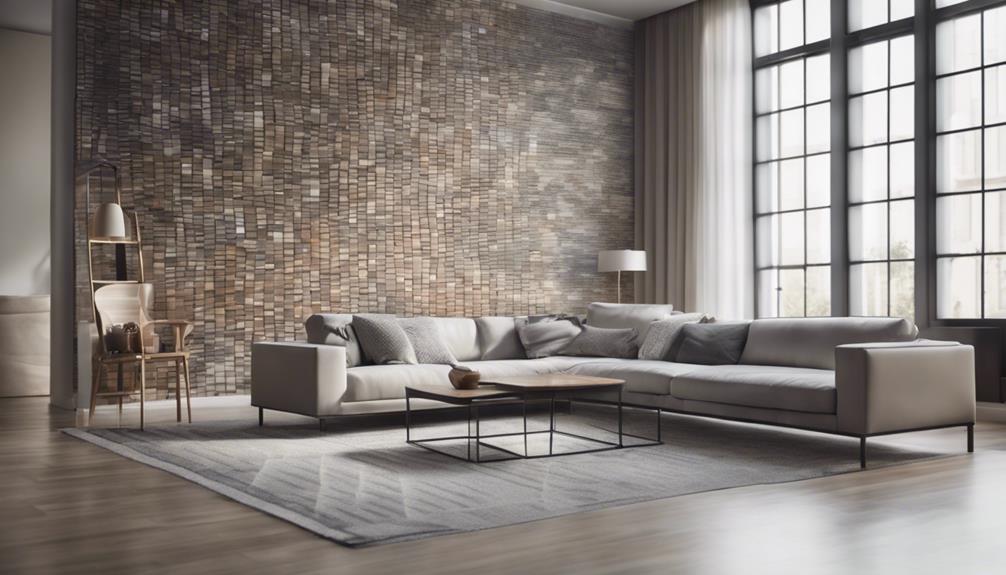
As you explore modern brick inlay design, you'll discover a world of possibilities for creating a unique and stylish accent wall. From choosing the perfect brick pattern to blending materials in innovative ways, you'll have plenty of options to make your design truly one-of-a-kind.
Now, let's take a closer look at the key points that will help you bring your modern brick inlay design to life:
brick pattern options,
unique material blends,
and inlay design variations.
Brick Pattern Options
Modern brick inlay designs offer a fresh, contemporary spin on traditional brick walls, allowing you to create a unique and visually appealing accent wall that elevates any room's style. With modern brick inlay designs, you can add a stylish touch to your space without sacrificing sophistication.
The intricate designs of modern brick inlay add depth and texture to the space, making it perfect for creating an accent wall.
Some popular brick pattern options include:
- Herringbone patterns that create a sense of movement and energy
- Chevron patterns that add a modern, edgy vibe
- Alternating brick patterns that create a sense of rhythm
- Interlocking brick patterns that add a touch of whimsy
These designs offer a contemporary twist on traditional brick walls, allowing you to create a one-of-a-kind accent wall that reflects your personal style.
Unique Material Blends
By blending traditional brick with materials like glass, metal, or reclaimed wood, unique material blends can add an extra layer of sophistication and visual interest to your modern brick inlay design. This fusion of old and new creates a striking focal point in your accent brick wall, perfect for making a statement in any room. With unique material blends, you can incorporate contemporary elements into your traditional brick walls, adding a personalized touch to your space.
| Material Blend | Visual Interest | Design Flexibility |
|---|---|---|
| Brick + Glass | Adds shine and reflection | Can create a modern, sleek look |
| Brick + Metal | Incorporates industrial chic | Offers a rugged, edgy vibe |
| Brick + Reclaimed Wood | Brings warmth and coziness | Can evoke a rustic, natural feel |
Inlay Design Variations
You can take your brick accent wall to the next level with inlay design variations that incorporate intricate patterns and geometric shapes, adding a contemporary touch to your space. These modern designs create visual interest and depth in a room, making your brick wall a stunning focal point.
With inlay designs, you can customize the patterns to fit your unique style, ensuring your space reflects your personality.
Here are some ideas to get you started:
- Hexagonal patterns that add a touch of sophistication
- Herringbone designs that create a sense of movement
- Geometric shapes that add a pop of color
- Nature-inspired patterns that bring the outdoors in
Distressed Brick Accent Wall Style

As you consider incorporating a distressed brick accent wall into your design, you'll want to think about the unique charm it can bring to a room.
The weathered look and rustic texture of distressed brick can add a level of character to your space that's hard to replicate with other materials.
Weathered Look Charm
Achieve a warm, inviting atmosphere in your home with a distressed brick accent wall, which instantly adds a weathered look charm that's both rustic and refined. This style of accent wall is perfect for creating a cozy, lived-in atmosphere that makes you feel like you're walking into a vintage retreat.
The distressed finish of the brick creates a sense of history and authenticity in the space, adding character and warmth to your interior.
Some of the key benefits of a distressed brick accent wall include:
- A unique texture that adds depth and visual interest to your room design
- A vintage aesthetic that adds character and warmth to your interior
- A rustic appeal that creates a cozy, inviting atmosphere
- An aged charm that makes your space feel like it's been lived in for years
Rustic Texture Accent
What's behind the enduring appeal of distressed brick accent walls, and how do they add a rustic texture to a room?
As you consider incorporating a brick wall into your design, you'll want to explore the distressed look, which brings a unique charm to any space.
The worn appearance of distressed brick creates a vintage and aged look that's perfect for industrial and farmhouse design themes.
This style of brick accent wall adds character and charm to the space, making it a popular choice for those seeking a one-of-a-kind focal point.
The texture of distressed brick provides a unique and eye-catching element in a room, drawing the eye towards its rustic beauty.
When you incorporate a distressed brick accent wall into your design, you'll be rewarded with a space that exudes warmth and personality.
Brick Veneer Accent Wall Ideas
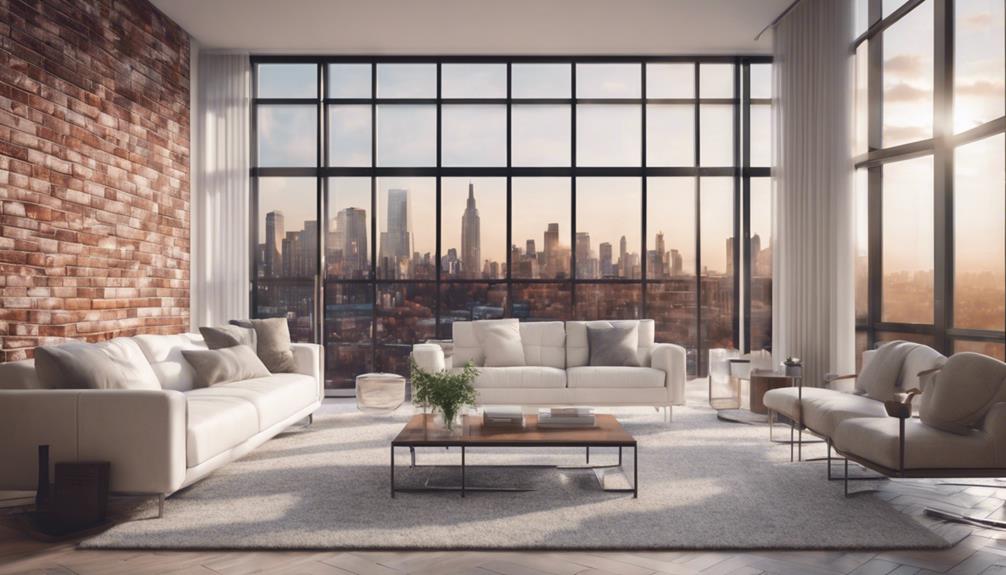
By incorporating brick veneer accent walls into your design, you can instantly add a touch of sophistication and character to any room. This cost-effective solution offers a realistic brick look without the hefty price tag or structural modifications.
With a variety of colors, textures, and styles to choose from, you can easily find a brick veneer that complements your interior design.
Here are some inspiring ideas to get you started:
- Create a modern, industrial-style kitchen with a white brick veneer accent wall that adds a touch of rustic charm.
- Use brick veneer to add warmth and texture to a minimalist interior, creating a cozy atmosphere.
- Incorporate brick veneer into your living room design to add character and create a unique focal point.
- Pair brick veneer with sleek, modern furniture to create a striking contrast that elevates your interior style.
With brick veneer accent walls, the possibilities are endless, and the result is always a space that exudes style and sophistication.
Reclaimed Brick Decor Inspiration
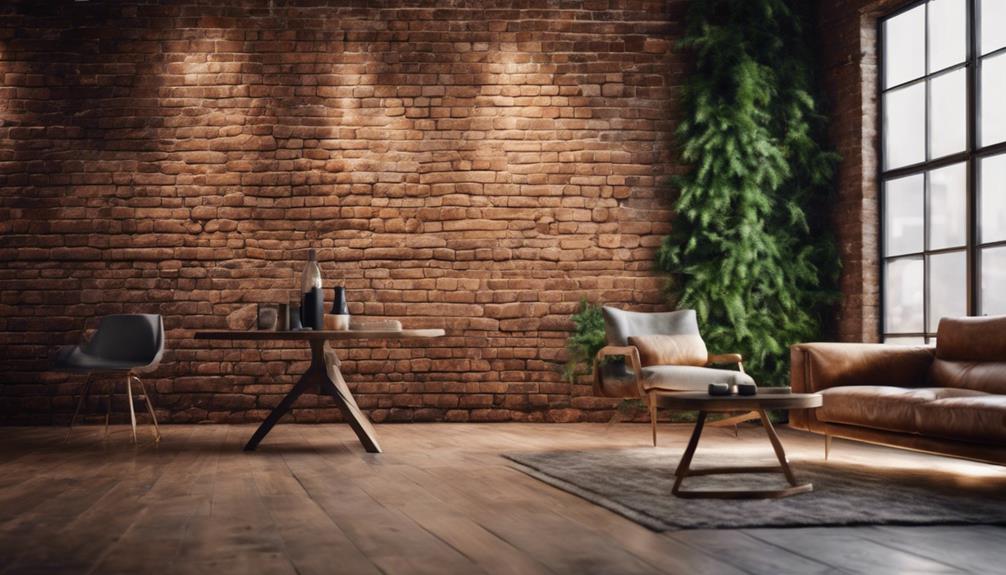
Bring a touch of history into your home with reclaimed brick decor, which injects a dose of authenticity and uniqueness into your interior design.
By incorporating reclaimed brick accent walls, you'll add a rustic and authentic touch to your interior spaces. These walls are made from salvaged bricks with unique textures and colors, creating a warm and inviting atmosphere in any room.
Not only do they bring character to a space, but they're also sustainable and eco-friendly design elements. Incorporating reclaimed brick into your decor can add a sense of history and charm to your home, making it truly one-of-a-kind.
With reclaimed brick, you'll get a unique blend of rustic charm and modern style, perfect for creating a cozy retreat or a statement piece. So, why settle for ordinary walls when you can have a work of art that tells a story?
Get inspired by reclaimed brick decor and transform your space into a true masterpiece.
Thin Brick Wall Design Concepts
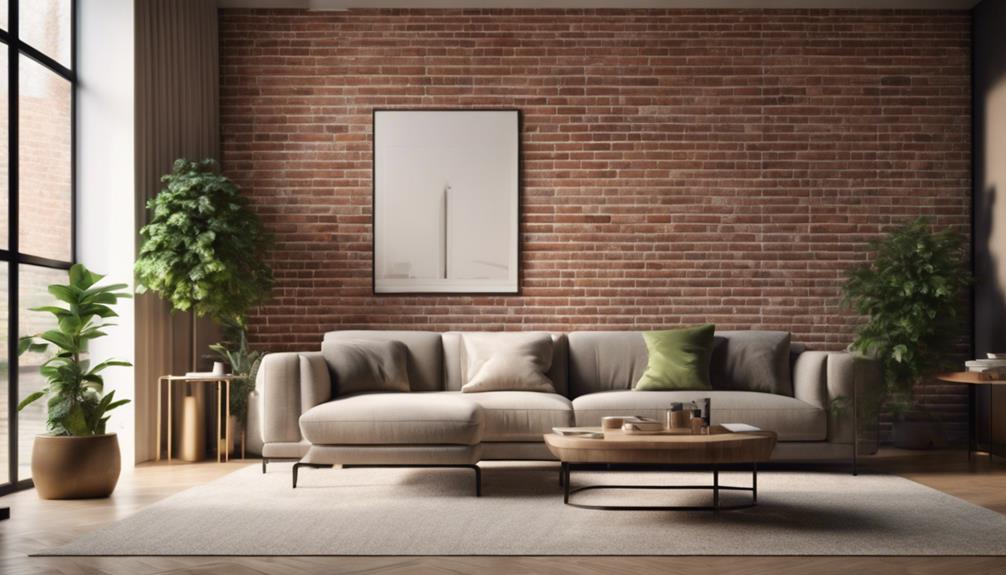
As you explore thin brick wall design concepts, you'll discover the versatility of these accent walls lies in their ability to incorporate various brick patterns, which can add a unique visual flair to any room.
By combining different patterns, such as herringbone or running bond, you can create a one-of-a-kind design that showcases your personal style.
With thin brick accent walls, you can also experiment with texture, introducing an extra layer of visual interest to your space through the subtle variations in brick texture.
Brick Pattern Variety
You can create a one-of-a-kind accent wall by mixing and matching different brick patterns, such as herringbone, basket weave, and running bond, to add visual interest and texture to your interior space. With a brick pattern variety, you can achieve a unique accent wall that reflects your personal style.
Thin brick walls offer flexible design options, allowing you to experiment with different layouts to create a modern or traditional look.
Some popular brick patterns to consider include:
- Herringbone: a classic pattern featuring alternating bricks that create a zigzag design
- Basket weave: a pattern that resembles a woven basket, adding depth and texture to your wall
- Running bond: a classic pattern featuring bricks laid in a staggered pattern
- Stack bond or soldier course: modern patterns that add a sleek, contemporary touch to your space
Textured Visual Interest
Thin brick accent walls inject textured visual interest into interior spaces, offering an authentic brick look and feel that adds depth and character to any room. As you incorporate thin brick into your design, you'll notice the texture that will make your space feel cozier and more inviting.
The rustic charm of thin brick creates an ambience that's perfect for relaxed gatherings or intimate moments. By adding style to your interior, thin brick accent walls create a focal point that draws the eye and sparks conversation.
Plus, with a variety of colors and patterns available, you can customize your thin brick wall to suit your unique aesthetic. For a cool accent, consider a whitewashed brick wall that adds a touch of rustic elegance to your space. Alternatively, you can create a contrasting look by pairing thin brick with sleek, modern elements.
Whatever your design style, thin brick accent walls are sure to add style and visual interest to your space.
Industrial Chic Brick Accent Wall

What kind of industrial chic vibe do you want to create in your space with an exposed brick accent wall?
With industrial chic brick accent walls, you can add a raw, urban vibe to any space. Exposed brick creates a visually striking and textural focal point in a room, making it a versatile design element suitable for modern, industrial, or eclectic styles.
Here are some ways to create an industrial chic brick accent wall:
- Imagine a statement wall with exposed brick, contrasted with sleek, modern furniture for a striking contrast.
- Envision a cozy reading nook surrounded by exposed brick, with plush armchairs and floor lamps.
- Picture a spacious loft with an exposed brick accent wall, paired with industrial-chic lighting fixtures and reclaimed wood furniture.
- Visualize a minimalist space with an exposed brick accent wall, complemented by monochromatic decor and sleek lines.
Whitewashed Brick Accent Wall Look
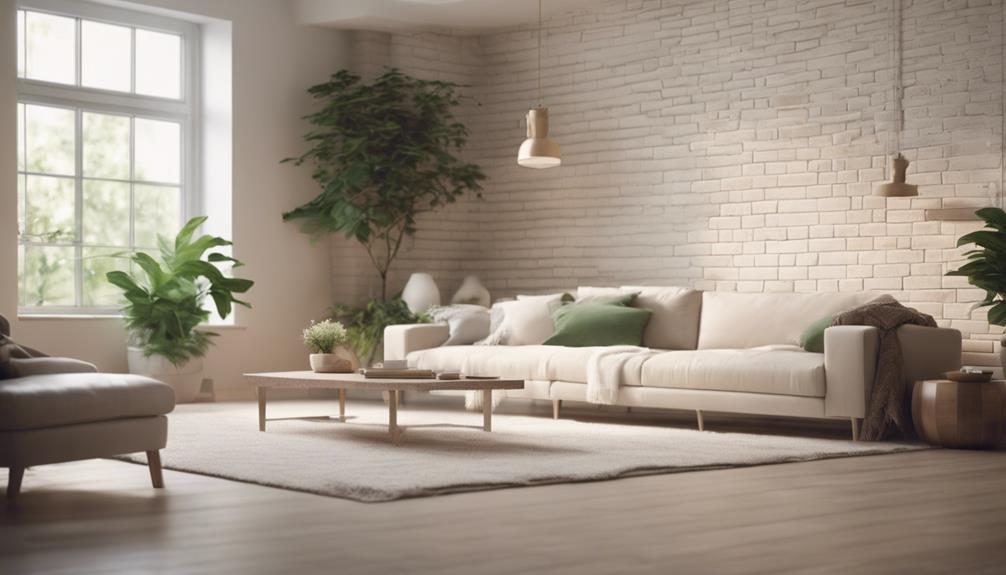
Whitewashing transforms brick into a charming, vintage-inspired accent wall that warms up any space with its soft, textured appeal. As you incorporate whitewashed brick into your design, you'll notice how it adds a touch of character to your room. The softening effect of whitewashing brick creates a warm and inviting atmosphere, perfect for cozying up your space.
| Benefits | Description |
|---|---|
| Adds Character | Whitewashed brick accent walls offer a unique, vintage charm that adds character to any room. |
| Provides Texture | The soft, textured appeal of whitewashed brick adds depth and visual interest to your space. |
| Versatile Backdrop | Whitewashed brick provides a neutral, versatile backdrop that complements various design styles. |
| Fresh Twist | Whitewashed brick accent walls offer a fresh and modern twist on traditional brick walls. |
| Warmth and Cozy | Whitewashing brick softens its appearance, creating a warm and cozy atmosphere in your space. |
Classic Brick Arch Accent Wall
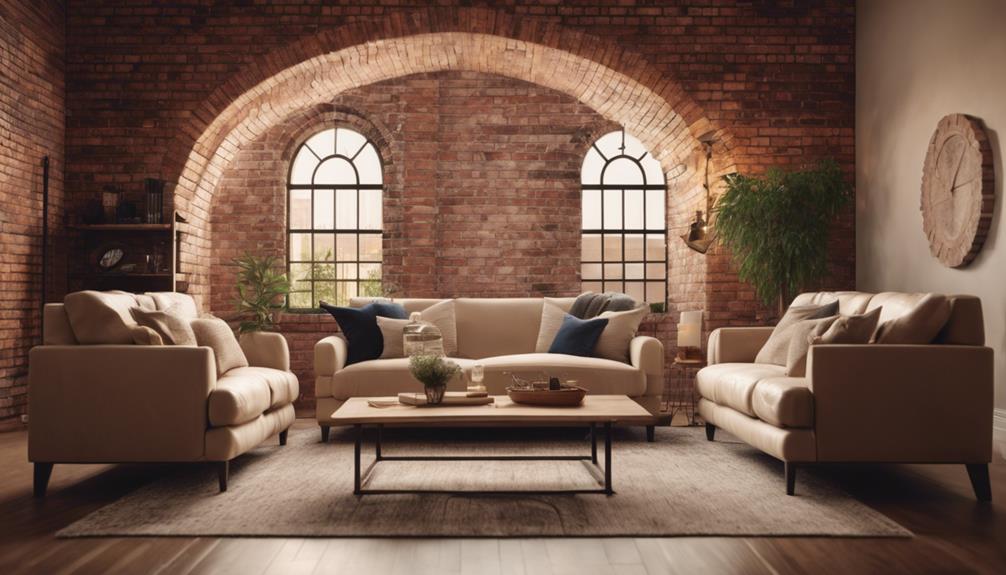
As you incorporate a classic brick arch accent wall into your design, you'll discover how its timeless charm and rustic appeal can elevate any space. This versatile design element can complement various interior styles, from industrial to farmhouse, adding a warm and inviting atmosphere to any room.
Here are some key benefits of incorporating a classic brick arch accent wall into your design:
- Creates a focal point in the room, drawing attention and adding character
- Adds a touch of rustic charm, perfect for creating a cozy atmosphere
- Can be paired with traditional brick materials to create a cohesive look
- Can be used to create a sense of warmth and intimacy in a large, open space
With its timeless design and rustic charm, a classic brick arch accent wall is sure to elevate any space. Whether you're looking to add a touch of industrial chic or cozy farmhouse charm, this design element is sure to impress.
Frequently Asked Questions
How Can I Make My Brick Wall More Attractive?
To make your brick wall more attractive, you'll want to highlight its natural texture and color variations. Consider incorporating lighting fixtures to showcase its unique features.
You could also add a pop of color by painting the brick in a bold or contrasting hue. Additionally, incorporate decorative elements like artwork, mirrors, or shelves to enhance the visual appeal.
How to Decorate a Brick Accent Wall?
As you stand before your brick accent wall, it's like a blank canvas waiting for your creative brushstrokes.
To decorate it, start by considering the room's style and theme. Add a statement piece, like a large piece of art or a mirror, to draw the eye towards the wall.
Then, balance it with complementary decor, such as vases, candles, or plants, to create a harmonious look that ties the room together.
How Do You Make a Stunning Accent Wall?
To create a stunning accent wall, you'll want to start by selecting a focal point, like a statement piece of art or a show-stopping light fixture.
Then, choose a color scheme that complements the room's overall aesthetic, and consider adding texture with materials like brick, wood, or fabric.
Don't be afraid to mix and match patterns, and don't forget to balance bold elements with neutral accents to avoid visual overload.
How to Modernize a Brick Wall?
As you start modernizing your brick wall, remember that 'Rome wasn't built in a day.'
Begin by painting the wall a neutral color to create a blank canvas.
Then, incorporate sleek shelving or artwork to introduce a contemporary flair.
Don't be afraid to mix materials, like wood and metal, to add depth and visual interest.
Conclusion
You've made it to the end of this brick-filled journey, and hopefully, you're not feeling like you've hit a wall (pun intended).
Ironically, the most challenging part of incorporating a brick accent wall into your design is probably deciding which stunning idea to choose from.
With these 10 striking concepts, you're bound to find the perfect blend of style and substance to elevate your space.
So, get ready to break out the bricks (or not, depending on your chosen design) and start building your dream space!
Vivienne – Your Content Companion Vivienne is your content companion, curating valuable tips, advice, and inspiration to guide you on your home decor journey. From insightful blog posts to informative product descriptions, she’s here to empower you with the knowledge you need to create your dream space.
Home Decor
What Are Indonesia’s Sustainable Rural Design Trends?
What are Indonesia’s sustainable rural design trends that integrate traditional knowledge and modern practices, and how do they shape the future of local communities?
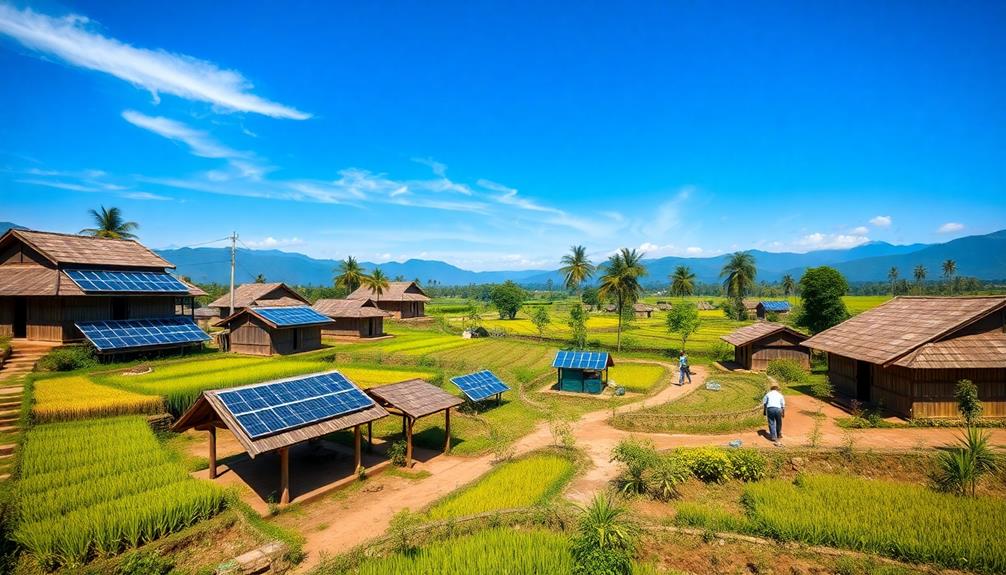
Indonesia's sustainable rural design trends focus on integrating Traditional Ecological Knowledge (TEK) with modern approaches to enhance community resilience. You'll see participatory design methods empowering locals as co-designers, ensuring that their unique needs are met. Initiatives like the Taba Padang village's forest scheme promote sustainable farming while preserving biodiversity. Engagement strategies emphasize collaboration, fostering social innovation and ownership. These trends not only enrich local identity but also improve economic prospects through sustainable practices, like cultivating traditional crops. There's so much more to explore about Indonesia's journey toward sustainability, and these trends are just the beginning.
Key Takeaways
- Integration of Traditional Ecological Knowledge (TEK) enhances sustainable farming practices and aligns agriculture with ecological cycles in rural communities.
- Community-driven initiatives, such as village forest schemes, promote biodiversity and prevent deforestation while improving crop yields.
- Participatory design empowers local residents to co-create sustainable solutions, fostering community engagement and ownership in development projects.
- Ethnographic methods document local cultural practices, ensuring that design outcomes reflect unique community identities and needs.
- Increased market access through improved transportation, like motorbikes, supports economic development and sustainable livelihoods for rural farmers.
Impact of Industrialization and Urbanization
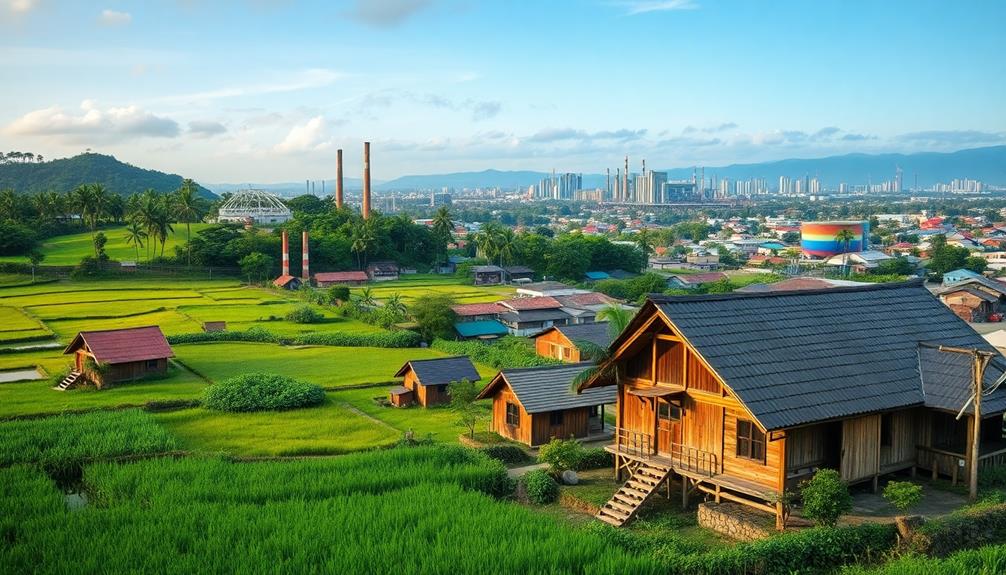
The rapid industrialization and urbanization in Indonesia have profoundly reshaped rural communities and their traditional farming practices. Since the Green Revolution in 1968, mechanized farming techniques have taken root, greatly reducing biodiversity in rural areas.
You may find that the vibrant cultural expressions, such as the Indonesian Decor Mask, are increasingly at risk as these changes take hold. You've likely noticed how urbanization policies have deepened the economic divide, exploiting rural resources and pushing poverty levels higher—12.36% of the rural population faced this challenge as of September 2022.
This shift towards profit-driven, efficient farming hasn't only led to ecological degradation but also eroded cultural practices central to these communities' identities.
As you observe these changes, it's clear that sustainable development is essential for the future of rural Indonesia. Integrating Traditional Ecological Knowledge (TEK) into modern agricultural practices can foster resilience in these communities.
TEK embodies local wisdom and ecological balance, offering invaluable insights that modern methods often overlook. By embracing sustainable design practices that honor these traditions, you can help mitigate the vulnerabilities faced by rural areas, ensuring that their unique cultural heritage and ecological health are preserved.
This approach not only benefits the environment but also strengthens community ties and identity.
Participatory Design and Co-Creation
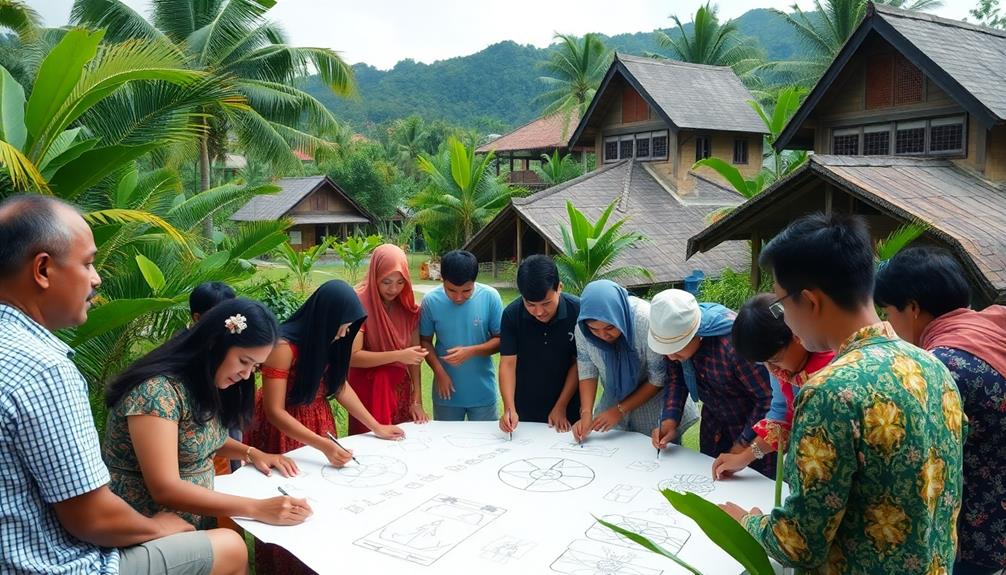
While rural communities in Indonesia face significant challenges from industrialization and urbanization, participatory design and co-creation offer a pathway to empower local residents. This approach emphasizes active involvement, treating community members as co-designers. It fosters social transformation and sustainability by engaging locals in decision-making processes, which is vital as these communities navigate the pressures of modern housing trends and the need for cultural preservation, as seen in the traditional and modern elements of Indonesian housing.
The participatory design process includes five key activities: initiation meetings, treasure mapping, idea generation, craft design workshops, and project reflection. These activities guarantee that everyone's voice is heard, allowing you to contribute to the outcomes that affect your life. Ethnographic methods document local perspectives and cultural activities, reflecting the unique needs and identities of your community.
Co-creation of knowledge enhances local narratives, empowering you and your neighbors to make collective decisions. By integrating Traditional Ecological Knowledge (TEK) into participatory design practices, you strengthen community empowerment and environmental stewardship.
This connection fosters a deeper understanding of sustainable practices that benefit both your community and the environment.
Role of Traditional Ecological Knowledge

Harnessing Traditional Ecological Knowledge (TEK) in Indonesia reveals the invaluable insights local communities possess about their environment and sustainable practices. TEK emphasizes local wisdom, like Niteni, which encourages observing natural phenomena to guide sustainable farming activities.
This approach mirrors the principles found in traditional Indonesian housing, where local materials and ecological awareness shape building practices. By applying the Pranatamangsa system, farmers align their agricultural practices with ecological cycles, enhancing their yields while ensuring sustainability.
Incorporating TEK into modern participatory design practices not only enriches community identity but also fosters pride, driving local engagement in sustainable development initiatives.
This approach promotes environmental stewardship by preserving traditional crop varieties and agricultural methods that are more resilient to climate change.
Community Engagement Strategies

Building on the foundation of Traditional Ecological Knowledge (TEK), community engagement strategies in Indonesia focus on involving local residents as active participants in the design process. This participatory approach encourages you to become a co-designer, fostering social innovation and sustainable development within your community.
For instance, incorporating elements of Indonesian Decorative Pillows can enhance living spaces while reflecting local culture and craftsmanship. In places like Sabrang Village, ethnographic methods help document local cultural practices, ensuring your perspectives and identities shape the design outcomes.
Collaborative workshops bring together local community members and external stakeholders—58 participants in total—to enhance engagement and ownership in development projects. By integrating TEK into these practices, you empower your community with local wisdom and sustainable agricultural methods that promote environmental stewardship.
Moreover, the co-creation of knowledge through participatory learning enriches local narratives, allowing you and your neighbors to collectively tackle challenges and support sustainable regional development.
Case Studies of Sustainable Practices
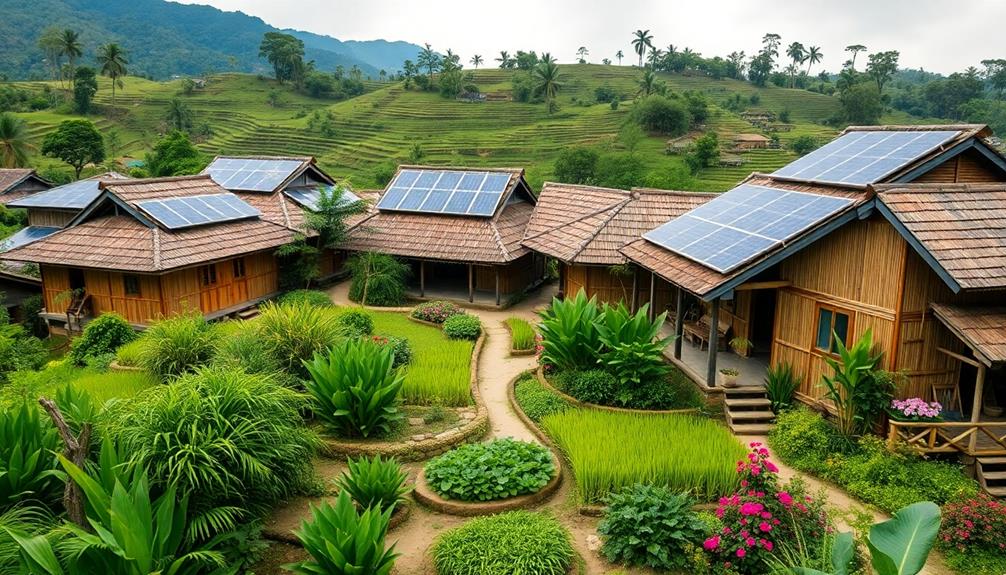
Sustainable practices in Indonesia showcase the transformative power of community-driven initiatives, especially in rural areas. Take Taba Padang village in southwest Sumatra, for example. Here, 470 households have embraced a village forest scheme, managing 1.5 hectares each in a protected forest. This approach promotes sustainable crop growth while preventing deforestation, allowing for the incorporation of local cultural elements into the farming practices, such as traditional planting techniques and community celebrations.
As a result, the community has seen increased incomes from cultivating coffee, pepper, durian, and rattan, which can be further enhanced through events that highlight their unique agricultural products Indonesian Party Decorations.
The introduction of motorbikes for harvest transportation has further improved farming operations, enhancing access to markets and making it easier for farmers to sell their products. Taba Padang's commitment to environmental conservation is evident in their shift from deforestation to reforestation. Regular inspections guarantee everyone adheres to sustainable practices, fostering a sense of responsibility within the community.
Recognized by the Indonesian Ministry of Environment and Forestry, Taba Padang's achievements highlight the potential for eco-tourism, thanks to its natural attractions like waterfalls and hot springs. This case study exemplifies how rural communities can thrive sustainably while protecting the environment, serving as a model for others looking to implement similar practices.
Frequently Asked Questions
What Are the Sustainability Plans of Indonesia?
Indonesia's sustainability plans focus on integrating smart village concepts and renewable energy projects. You'll see initiatives like the Emission Trading Scheme and carbon trading platforms aimed at enhancing community resilience and promoting environmental responsibility.
Why Are Rural Areas More Sustainable?
Imagine a thriving garden, where every plant shares its resources. In rural areas, community ties and traditional knowledge foster sustainability, allowing you to nurture the land and its diversity while ensuring a balanced, harmonious existence.
Conclusion
In Indonesia, the convergence of industrialization and a deep-rooted respect for traditional ecological knowledge creates a unique landscape for sustainable rural design. By embracing participatory design and community engagement, you're not just witnessing a trend; you're part of a transformative movement. Coincidentally, as rural areas adapt to modern challenges, they also revive age-old practices, illustrating that sustainability isn't merely a goal but a harmonious blend of past wisdom and present innovation, shaping a brighter future for all.
Home Decor
Emerging Sustainable Trends in Rural Design
Get ready to discover how innovative sustainable trends in rural design are transforming communities, but what groundbreaking practices are leading the way?
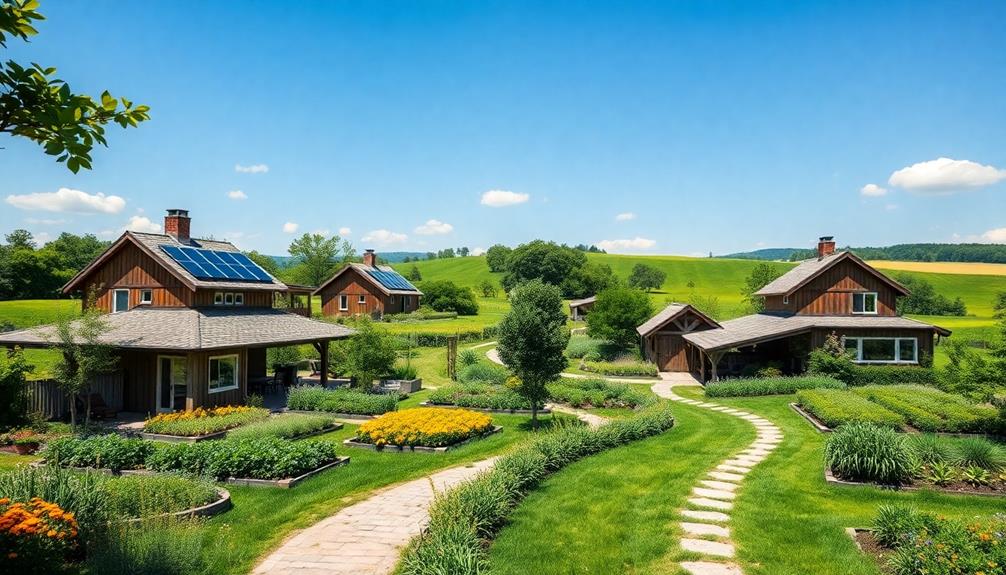
Emerging sustainable trends in rural design focus on eco-friendly practices that promote community resilience and environmental health. By integrating renewable energy solutions like solar panels, you enhance energy independence while reducing costs. Using local, natural materials supports economies and minimizes transportation emissions. Implementing water conservation techniques addresses resource scarcity effectively. Community-centric planning guarantees developments meet local needs and values, fostering social cohesion. Innovations in agriculture, such as precision farming, improve yields and sustainability. These trends not only uplift local economies but also enhance well-being. Keep exploring to uncover even more transformative practices reshaping rural landscapes today.
Key Takeaways
- Sustainable rural design emphasizes renewable energy integration, enhancing energy independence and reducing reliance on non-renewable sources.
- Community-centric planning practices ensure developments resonate with local needs and values, fostering social cohesion and quality of life.
- Nature-inspired design approaches enhance aesthetics and sustainability through passive solar design, green spaces, and local materials.
- Resource efficiency strategies, such as rainwater harvesting and locally sourced materials, significantly reduce waste and operational costs.
- Innovations in agriculture and renewable energy, like organic farming and micro-hydroelectric systems, boost local economies and promote ecological balance.
Overview of Sustainable Rural Design
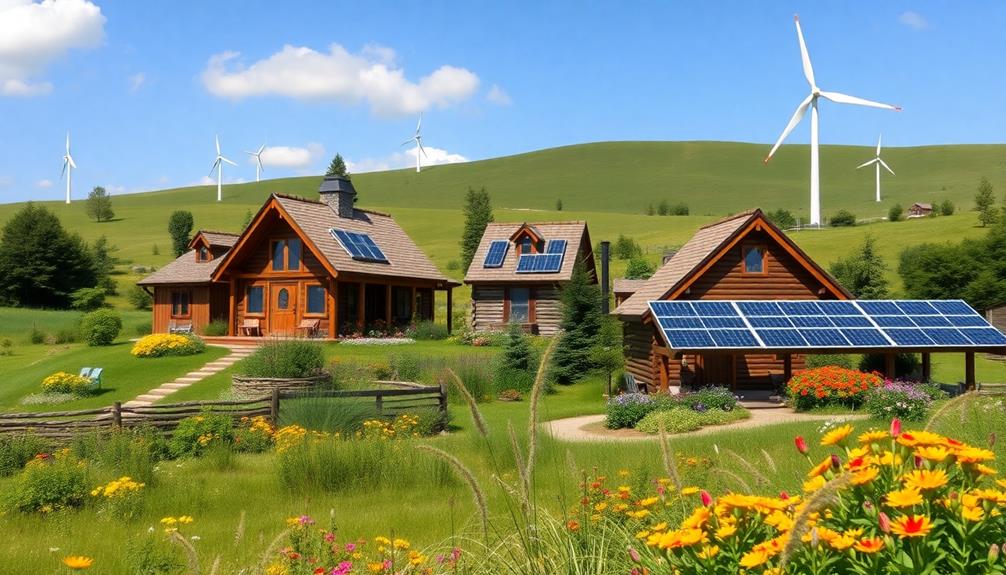
Sustainable rural design is increasingly becoming essential for creating resilient communities that thrive while respecting the environment. By integrating renewable energy solutions like solar panels and wind turbines, you can enhance energy independence in rural areas. These sources not only reduce reliance on fossil fuels but also lower energy costs over time.
Incorporating natural materials, similar to Balinese design characteristics, can further enhance sustainability and create a warm, inviting atmosphere. Using locally sourced materials such as compressed earth blocks can greatly reduce construction expenses while supporting local economies. This approach promotes sustainable living practices that benefit both the community and the environment.
Additionally, implementing water conservation techniques, including rainwater harvesting and greywater recycling, addresses pressing water scarcity issues effectively. Incorporating biophilic design principles into rural structures fosters a connection with nature, enhancing the well-being of occupants through green spaces and natural light.
You'll find that innovative housing solutions, like modular homes, offer cost-effective and energy-efficient options. These designs minimize construction waste and time while promoting eco-friendly practices.
Key Principles of Ecological Design
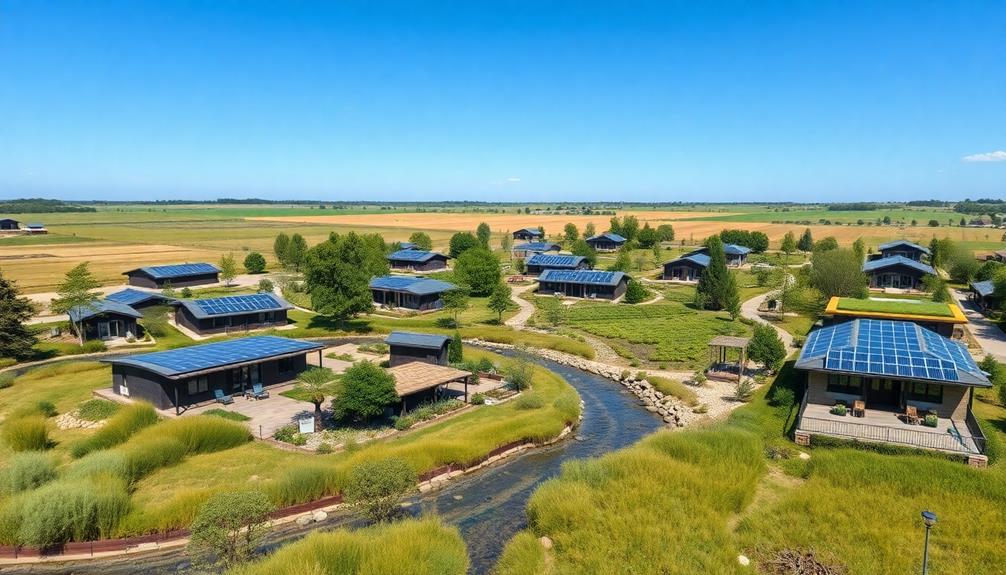
When you think about ecological design, consider how nature-inspired approaches can shape your projects.
Emphasizing harmony with nature, as seen in traditional Indonesian style home decor, can enhance the aesthetic while promoting sustainability.
You'll want to focus on resource efficiency strategies that minimize waste and maximize sustainability.
Plus, incorporating community-centric planning practices guarantees that your designs truly reflect the needs and values of the people living in those spaces.
Nature-Inspired Design Approaches
Embracing nature-inspired design approaches can transform rural architecture into vibrant, sustainable spaces that harmonize with their surroundings. By prioritizing biomimicry, you can emulate natural forms and processes, creating efficient structures that work seamlessly with ecosystems.
These sustainable architecture practices often utilize local materials and traditional building techniques, such as those found in traditional Indonesian housing, which reduce carbon footprints and celebrate cultural heritage.
Key elements of nature-inspired design include:
- Passive solar design: Optimize building orientation and thermal mass to cut energy consumption.
- Ecological design: Integrate green spaces and native landscaping to enhance biodiversity and improve air quality.
- Water management strategies: Implement natural ponds and rain gardens for effective water conservation.
- Local materials: Use materials sourced from nearby to minimize transportation emissions.
- Wildlife habitats: Create environments that support local fauna, promoting ecological balance.
Resource Efficiency Strategies
Resource efficiency strategies play a pivotal role in ecological design, building on the foundation of nature-inspired approaches. By prioritizing locally sourced materials, you can greatly reduce transportation emissions while supporting local economies.
For example, incorporating elements from traditional Indonesian wedding decor ideas can enhance community connections through locally sourced floral arrangements and handcrafted decor. Take, for instance, the rising popularity of compressed earth blocks and bamboo construction—these options embody sustainable choices.
Implementing rainwater harvesting systems and greywater recycling is another effective strategy. You could reduce water consumption by up to 50%, promoting sustainable water use in your community.
Furthermore, integrating renewable energy sources like solar panels and small wind turbines not only enhances energy independence but can also cut household energy costs by 30-50%.
Utilizing passive solar design techniques, such as strategic building orientation and thermal mass, helps you maximize natural heating and cooling, potentially reducing energy use for temperature regulation by 20-40%.
Additionally, embracing eco-friendly product designs, like low-cost cooking stoves and efficient irrigation systems, can lower resource consumption and operational costs.
These strategies collectively improve the quality of life for rural residents, making your community more sustainable and resilient in the long run.
Community-Centric Planning Practices
Community-centric planning practices are essential for fostering sustainable rural development that truly reflects the needs and values of local residents. By prioritizing community engagement and participatory design, you can guarantee that developments resonate with the people who'll use them.
Significantly, traditional Indonesian houses, such as Rumah Adat, emphasize community-oriented layouts that encourage social interaction and a sense of belonging. Studies have shown that this approach can lead to a 30% increase in community satisfaction.
Utilizing ecological design principles, such as:
- Incorporating local materials to reduce emissions and costs
- Designing green spaces that boost social cohesion and safety
- Integrating renewable energy solutions for economic resilience
- Promoting sustainable agricultural practices to enhance biodiversity
- Creating shared public areas that foster community interaction
These strategies not only support economic development but also enhance the quality of life in rural areas.
For instance, using compressed earth blocks can cut construction costs by 20%, while renewable energy solutions can reduce energy costs by 50%. By focusing on sustainable practices, you can create vibrant, thriving communities that prioritize both ecological health and resident well-being.
Embracing these community-centric approaches guarantees a holistic development model that benefits both people and the planet.
Community-Centric Planning Approaches
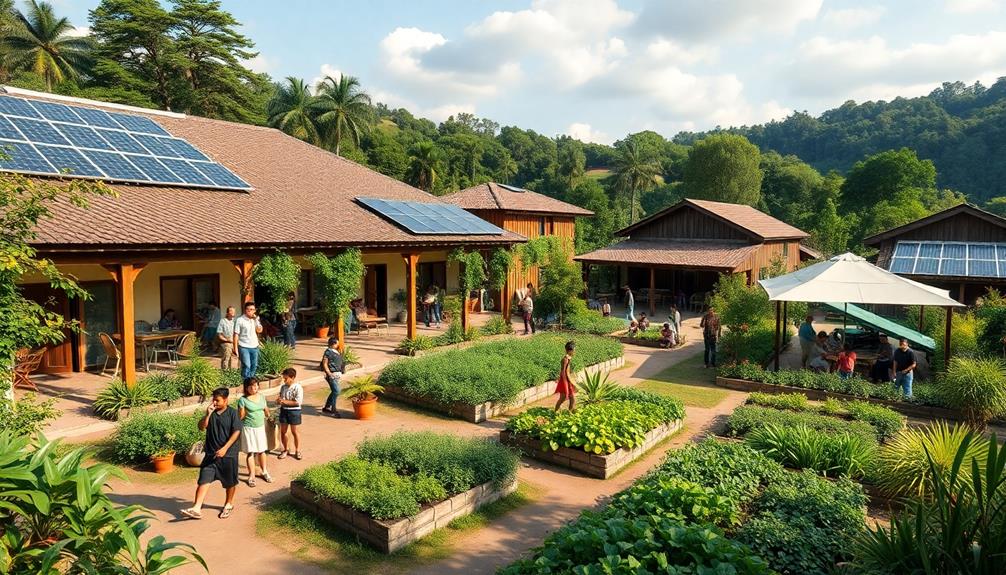
When you embrace participatory design methods, you empower your community to shape its own future.
Incorporating elements of local culture, such as Indonesian Decorative Pillows, can enhance the sense of identity and belonging among residents.
Engaging local residents not only enhances their connection to the area but also guarantees that developments truly reflect their needs and values.
Participatory Design Methods
Participatory design methods empower residents to take an active role in shaping their environment, guaranteeing that projects align with local needs and values. By engaging community members in the planning process, you foster a sense of community ownership and pride.
This approach can also reflect local craftsmanship, similar to how the intricate designs of Indonesian decor masks enhance cultural appreciation in various settings. Studies show that projects that involve local input are 30% more likely to be accepted and utilized, creating sustainable solutions that truly reflect the community's unique characteristics.
Here are some key aspects of participatory design:
- Inclusivity: Engaging diverse backgrounds guarantees all voices are heard.
- Workshops: Collaborative sessions allow community members to share their ideas.
- Cultural relevance: Designs become contextually appropriate, reflecting local traditions.
- Social cohesion: Strengthening relationships among residents improves overall quality of life.
- Empowerment: Community members gain confidence in their ability to influence change.
Enhancing Local Engagement
Engaging local residents in the planning process not only builds on the principles of participatory design but also fosters a deeper connection to the projects that shape their environment.
When you prioritize community input, you guarantee developments reflect local traditions and values, enhancing inclusivity. This approach cultivates a sense of ownership, making residents more likely to embrace and utilize community projects.
By integrating elements of tropical architecture that resonate with local culture, such as open spaces and natural light, you can further enhance the sense of belonging within the community.
Involving diverse stakeholders, including marginalized groups, promotes social cohesion and addresses historical disparities in rural development.
By integrating local knowledge, you're more likely to identify unique environmental and social considerations that standard practices might overlook, leading to sustainable outcomes.
Moreover, successful community engagement has been linked to improved mental health and well-being.
When you strengthen social networks and create spaces that encourage interaction, you support community activities that enhance overall quality of life.
Innovations in Renewable Energy

Rural areas are witnessing a surge in renewable energy innovations that are transforming how communities power their lives. By investing in sustainable energy sources, you can enhance energy independence and greatly reduce greenhouse gas emissions.
For instance, solar energy is projected to account for about 20% of global electricity generation by 2040, making it a key player in rural energy strategies. The emphasis on sustainable craftsmanship in Balinese furniture also reflects a growing trend towards eco-friendly practices in various sectors.
Consider the benefits of these innovations:
- Micro-hydroelectric systems: Harness flowing water to create decentralized energy solutions, cutting costs by up to 30%.
- Solar-powered irrigation systems: Boost agricultural efficiency, potentially increasing crop yields by 20-30%.
- Wind energy projects: Provide reliable power while supporting local job opportunities in the renewable energy sector.
- Energy independence: Reduces reliance on non-renewable sources, allowing rural communities to thrive sustainably.
- Economic growth: The renewable energy sector is expected to create over 24 million jobs globally by 2030.
Sustainable Agriculture Practices

Sustainable agriculture practices are revolutionizing how we produce food while minimizing environmental impact. By focusing on efficient resource management and innovative techniques, these practices not only enhance food production but also promote biodiversity conservation. You can see how various methods contribute to sustainable food sources in the table below:
| Practice | Benefits |
|---|---|
| Organic Farming | Reduces chemical use |
| Precision Farming | Increases crop yields by 20-30% |
| Agroecological Practices | Enhances ecosystem health |
| Water Management Innovations | Cuts water usage by up to 30% |
| Local Seasonal Production | Supports food security in rural communities |
Adopting these sustainable agriculture practices addresses critical challenges, including water scarcity and the need for food security. By emphasizing local food production, you can strengthen rural economies and foster community resilience. As the organic farming market is projected to reach $500 billion by 2025, it's clear that the shift toward sustainability is not just beneficial but essential for our future. Embrace these practices to help create a more sustainable world.
Enhancing Local Economies
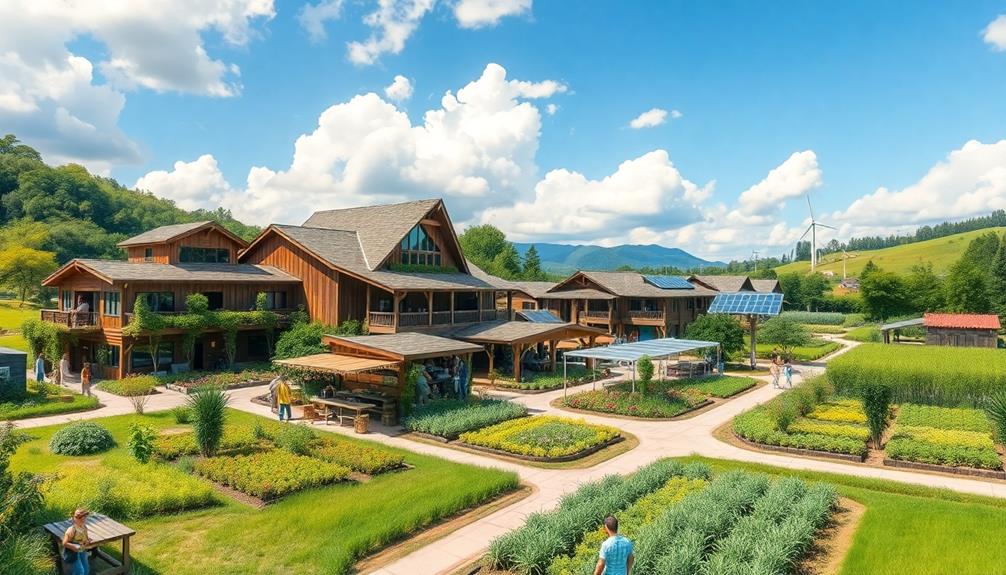
Investing in sustainable agriculture practices not only boosts food production but also lays the groundwork for enhancing local economies. By focusing on rural development, you're supporting initiatives that contribute around 30% to global GDP.
Additionally, incorporating elements of traditional artistry, such as Indonesian decor masks, can celebrate local culture and attract tourism, further promoting economic growth. This investment fosters economic growth and diversifies income sources, as non-farm activities now account for up to 50% of rural income in some areas.
Consider the following strategies to enhance local economies:
- Support renewable energy projects that create jobs and reduce dependency on non-renewable sources.
- Encourage sustainable entrepreneurship by providing training and resources for local business owners.
- Promote infrastructure investment, such as improved transportation networks, to enhance market access for local products.
- Expand access to financial services, including microfinance options, to empower entrepreneurs and stimulate economic development.
- Develop community programs that foster collaboration and knowledge-sharing among local businesses.
These sustainable practices not only improve the quality of life in rural areas but also create a robust ecosystem that drives long-term economic stability.
Health and Well-being in Design
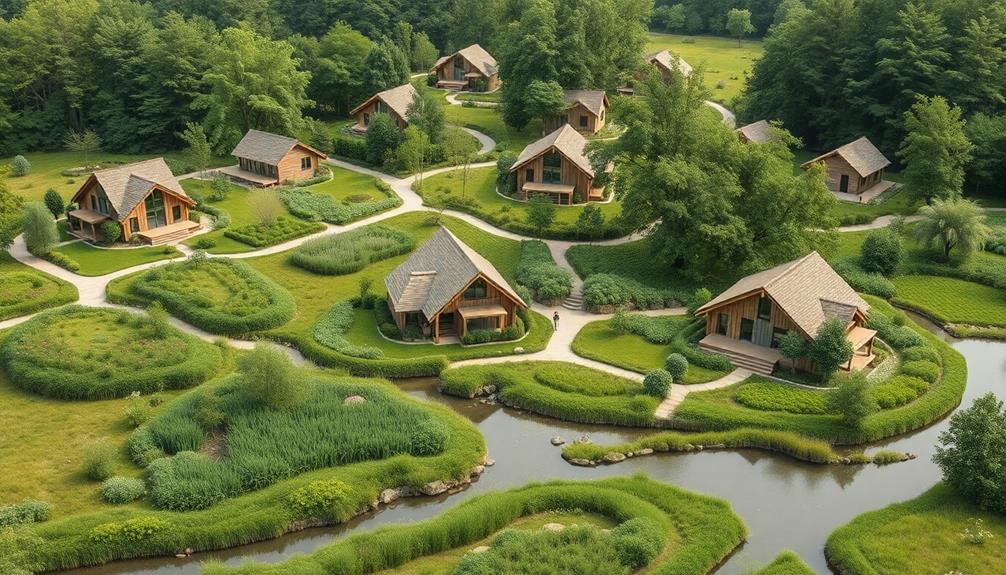
There's a growing recognition that the design of our living spaces greatly impacts health and well-being. By integrating biophilic design principles, you can create environments that foster mental well-being and reduce stress. Access to green spaces not only enhances air quality but also encourages physical activity, leading to improved physical health outcomes.
Natural light and proper ventilation are essential in rural homes, enhancing indoor comfort and productivity. Additionally, using eco-friendly materials minimizes indoor air pollutants, creating a healthier living environment. Community engagement is significant as it helps foster social connections, enhancing a sense of belonging that is fundamental for mental health.
Here's a quick summary of these key aspects:
| Design Element | Benefits |
|---|---|
| Biophilic Design | Reduces stress, boosts mental well-being |
| Access to Green Spaces | Improves air quality, enhances physical health |
| Natural Light | Increases comfort and productivity |
| Eco-Friendly Materials | Lowers indoor pollutants for healthier living |
Incorporating these elements not only promotes individual well-being but also strengthens community ties, ultimately leading to a healthier rural lifestyle.
Future Directions for Rural Development
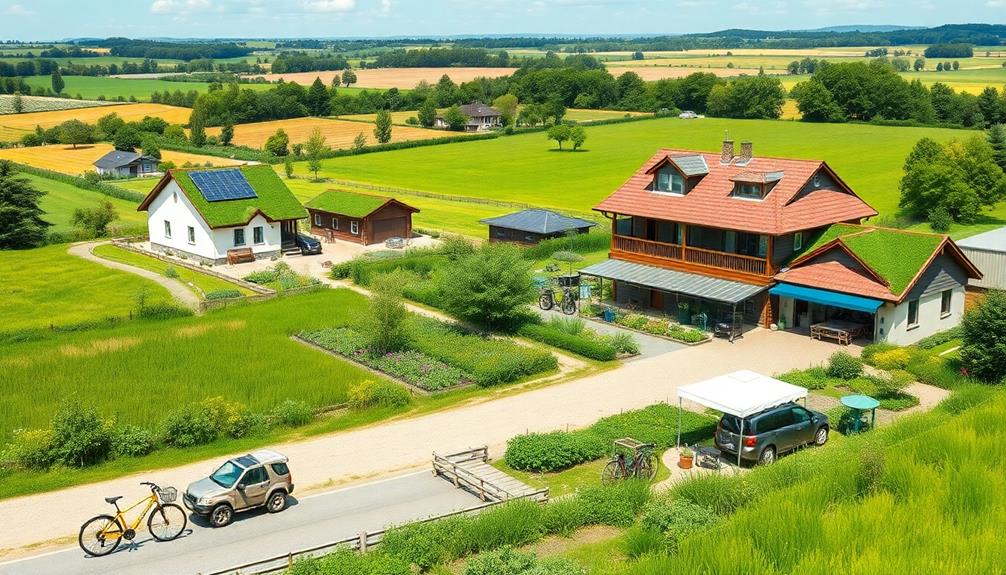
As rural development evolves, a clear focus on sustainable agriculture practices will shape the future landscape of these communities.
You'll see an increasing emphasis on innovative solutions that enhance food security and drive economic growth. The organic farming market, projected to reach $500 billion by 2025, is just one example of how sustainable development can transform rural areas.
Consider these key trends that will define future rural development:
- Investment in infrastructure: Improved transportation and utilities will create better access to markets.
- Precision farming technologies: These advancements promise to boost crop yields by 20-30%, optimizing natural resources.
- Rural entrepreneurship: Non-farm activities can contribute up to 50% of rural income, fostering innovation and job creation.
- Energy efficiency initiatives: Adopting eco-friendly living practices will reduce waste and enhance sustainability.
- Access to education: Educational programs will empower residents, equipping them with skills for new employment opportunities.
As you engage with these developments, you'll witness a more resilient and sustainable future for rural communities, ultimately leading to a thriving, eco-friendly lifestyle.
Frequently Asked Questions
What Are the Examples of Sustainable Development in Rural Areas?
You'll find examples of sustainable development in rural areas like renewable energy projects, organic farming, eco-friendly modular housing, community-driven design, and innovative water management systems, all enhancing local independence, efficiency, and environmental conservation.
How to Promote Sustainability in Rural Areas?
Imagine a future where your community thrives—by adopting renewable energy, sustainable agriculture, eco-friendly housing, and efficient water management. You can engage locals, ensuring their needs shape projects, fostering lasting change and shared ownership of a sustainable tomorrow.
What Are the Sustainable Development Goals of Rural Development?
The sustainable development goals for rural development focus on eradicating poverty, ensuring food security, managing water resources, promoting economic growth, and enhancing urban-rural connections. You'll play a key role in achieving these goals through local initiatives.
What Are the Challenges of Rural Sustainability?
Rural regions wrestle with resource restraints, aging populations, and climate changes. You'll face fragmented infrastructure and limited community involvement, making it tough to tackle sustainability challenges effectively and foster vibrant, resilient rural futures.
Conclusion
As you embrace these emerging sustainable trends in rural design, you'll cultivate greener landscapes, nurture stronger communities, and inspire healthier lifestyles. By prioritizing ecological principles, harnessing renewable energy, and supporting local economies, you'll create vibrant spaces that thrive today and tomorrow. Picture thriving farms, bustling markets, and interconnected neighborhoods, all blossoming under the sun of sustainability. Together, let's pave the way for a brighter, more resilient rural future, where nature and community flourish hand in hand.
Home Decor
Sustainable Rural Design Trends Shaping Indonesia
Uncover how sustainable rural design trends in Indonesia are transforming communities and preserving cultural heritage, creating a brighter future for its residents.
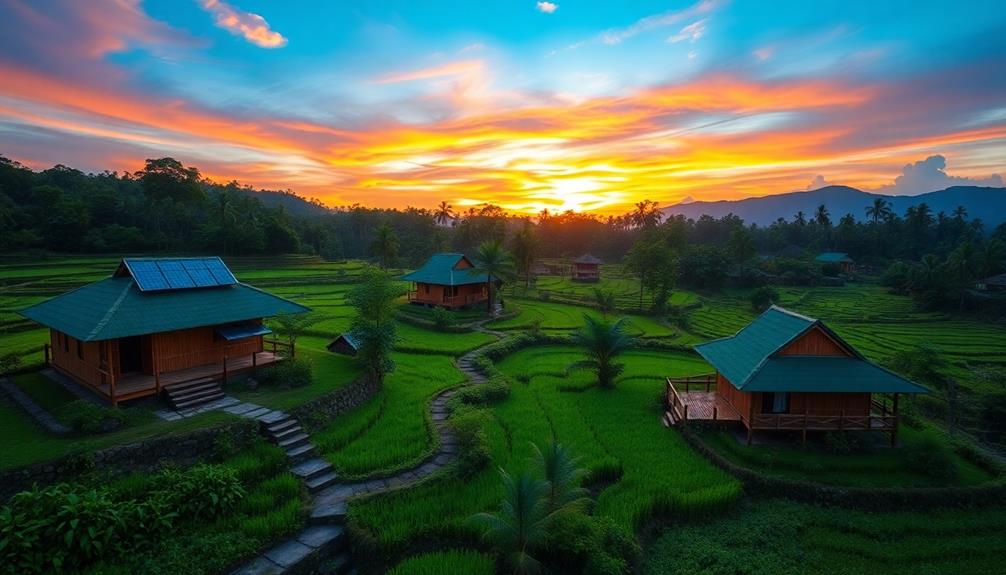
In Indonesia, sustainable rural design trends are transforming communities while respecting cultural heritage. You'll see a strong focus on participatory design, where locals co-create their environments, empowering them and preserving their identities. Traditional Ecological Knowledge plays a crucial role, guiding farming practices and promoting ecological balance. This approach not only fosters local pride but also boosts sustainable tourism, which generates economic benefits. Areas like Sabrang Village illustrate these principles, combining natural materials and local craftsmanship. Discover how these trends are shaping the future of rural Indonesia and enhancing the lives of its residents.
Key Takeaways
- Participatory design engages local residents as co-designers, fostering community identity and ensuring designs meet local needs.
- Traditional ecological knowledge (TEK) enhances sustainability and preserves regional identity through culturally rooted practices and natural observations.
- Case studies like Sabrang Village demonstrate successful integration of traditional craftsmanship and modern design principles for economic growth and community involvement.
- Sustainable tourism initiatives leverage cultural heritage, attracting visitors while boosting local economies and promoting environmental conservation.
- Emphasizing community engagement and ecological balance is crucial for revitalizing rural areas and addressing the impacts of industrialization.
Impact of Industrialization on Rural Areas

Industrialization has drastically altered the landscape of rural Indonesia, impacting both livelihoods and cultural traditions. You've likely noticed how mechanized farming methods have replaced traditional agricultural practices, leading to a significant loss of local biodiversity since the Green Revolution in 1968. This shift not only threatens the ecological balance but also diminishes the rich cultural practices tied to farming communities.
Traditional Indonesian housing, often designed to reflect the local environment and cultural values, is also at risk as modernization takes hold, with many communities losing their architectural heritage as a result of urbanization and economic pressures traditional homes and cultural symbolism.
Urbanization policies have exacerbated economic disparities, leaving rural areas struggling. With a rural poverty rate of 12.36% as of September 2022, many rural communities face increasing unemployment and school dropout rates. The focus on profit and efficiency in modern agriculture often neglects the needs of these communities, fueling social change that further isolates them from their cultural roots.
In this landscape, the necessity for sustainable development becomes clear. Supporting design practices that honor traditional methods while promoting ecological balance is essential for revitalizing rural areas. By fostering community engagement and sustainable practices, you can help bridge the gap between industrialization and the preservation of Indonesia's rich cultural heritage, creating a more equitable future for rural communities.
Participatory Design in Community Development
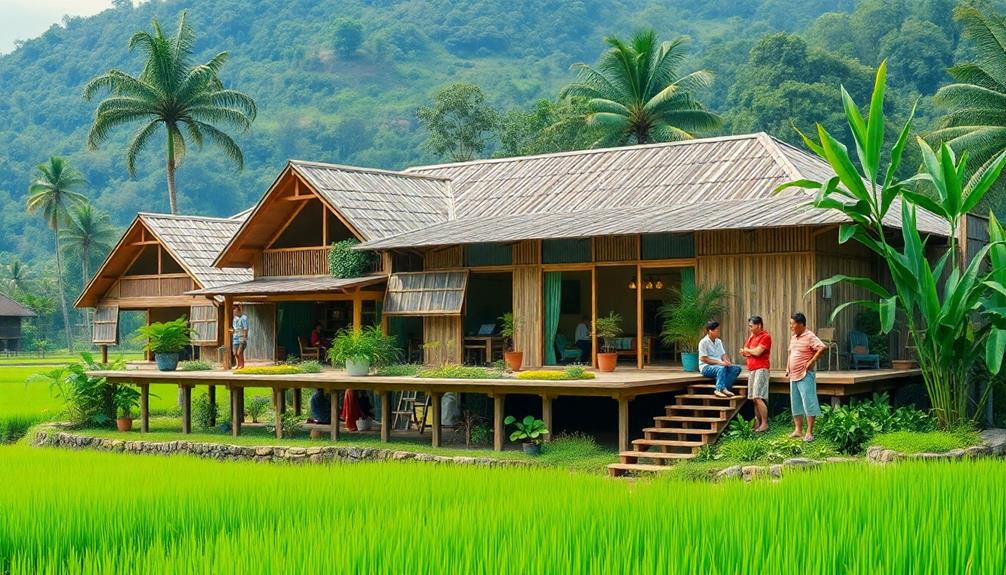
Participatory design transforms community development by actively engaging local residents as co-designers in the process. This approach empowers you and your neighbors, enhancing local narratives and identities while fostering collective decision-making.
By incorporating elements of Indonesian decorative pillows into community spaces, designs can reflect cultural heritage and enhance aesthetics. Through a structured process that includes initiation meetings, treasure mapping, idea generation, craft design workshops, and project reflection, participatory design guarantees thorough community engagement.
Employing ethnographic methods allows for a deep understanding of your community's life and cultural activities, resulting in designs that truly reflect local perspectives and needs. By involving you and your fellow community members in experiential learning, this method supports social innovation and sustainable development, addressing both human and ecological needs.
A recent project showcased the power of diverse collaboration, with 58 participants, including 24 local community members and 28 external stakeholders. This highlights the importance of engaging all voices in the community.
Ultimately, participatory design not only builds a sense of ownership among residents but also leads to solutions that are more viable and relevant. As you participate, you're not just contributing to a project; you're helping shape the future of your community.
Role of Traditional Ecological Knowledge
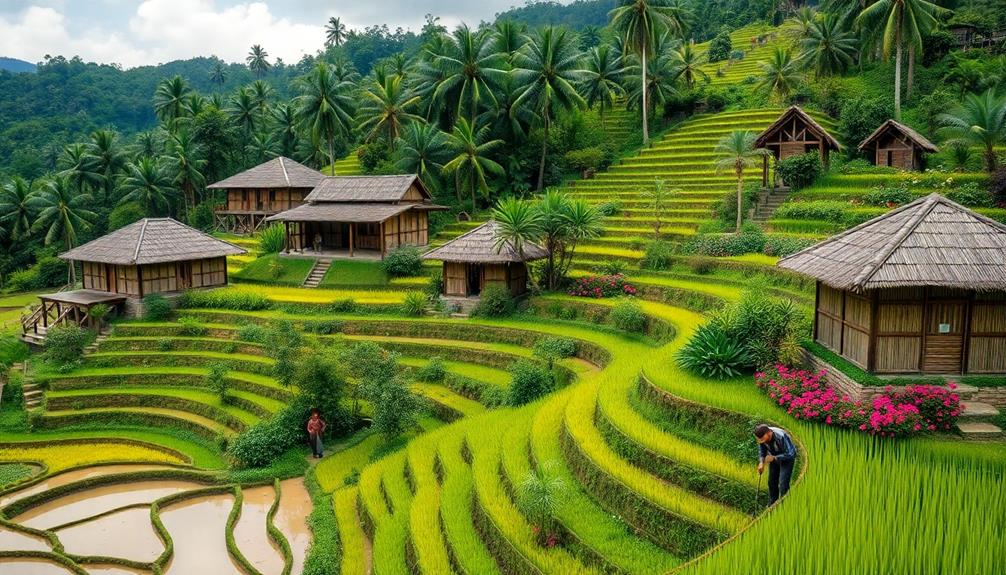
Harnessing the wisdom of Traditional Ecological Knowledge (TEK) is essential for achieving sustainable development in Indonesia. TEK reflects local cultural practices that promote ecological balance and sustainability. By observing natural phenomena through Niteni, farmers adapt their agricultural activities based on seasonal guidelines, enhancing yields while respecting the environment.
| TEK Element | Impact | Community Benefit |
|---|---|---|
| Seasonal Guidelines | Aligns farming with cycles | Increases agricultural resilience |
| Heritage Preservation | Maintains regional identity | Fosters local pride |
| Sustainable Tourism | Promotes eco-friendly travel | Boosts local economy |
Incorporating TEK into participatory design practices empowers communities and strengthens local wisdom. This co-creation of knowledge respects cultural identities and enhances regional development. By integrating these practices, you not only support sustainable tourism initiatives but also create a foundation for long-term ecological stewardship. Embracing TEK is a powerful way to guarantee that Indonesia's rich heritage thrives alongside modern advancements, creating a harmonious future for both the environment and its people.
Social Design and Community Engagement
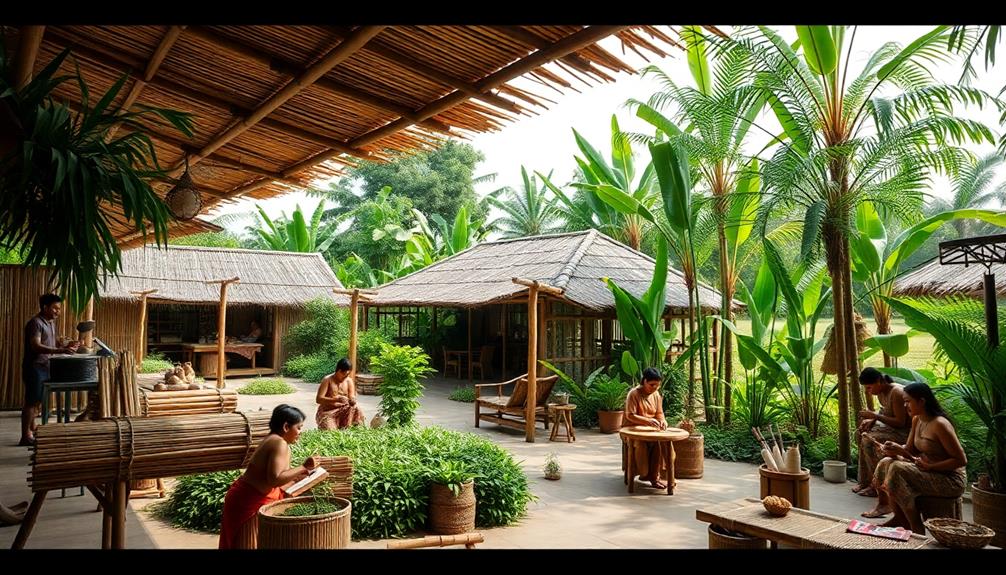
Building on the foundation laid by Traditional Ecological Knowledge, social design plays an essential role in fostering community engagement in rural Indonesia. This approach emphasizes openness and connectedness, driving social innovation and inspiring local communities to collaborate effectively.
By employing participatory design, you actively involve stakeholders, treating them as co-designers. This not only enhances community empowerment but also promotes sustainable regional development. Traditional Indonesian houses, known for their community-oriented layout, further underscore the importance of collaboration and social interaction within these rural settings, reflecting the cultural significance of housing.
Engagement in projects, like one involving 58 participants, highlights how regular consultations with local farmers and government representatives facilitate knowledge exchange and collective decision-making, vital for effective rural development.
Ethnographic methods capture community life and cultural activities, ensuring local perspectives inform design processes and strengthen cultural identity.
Moreover, community engagement through participatory learning encourages experiential knowledge acquisition, equipping residents with the skills necessary for resilience in rural areas.
As you immerse yourself in these processes, you'll realize that social design isn't just about creating structures or systems; it's about empowering communities to shape their environment.
Case Study: Sabrang Village Insights
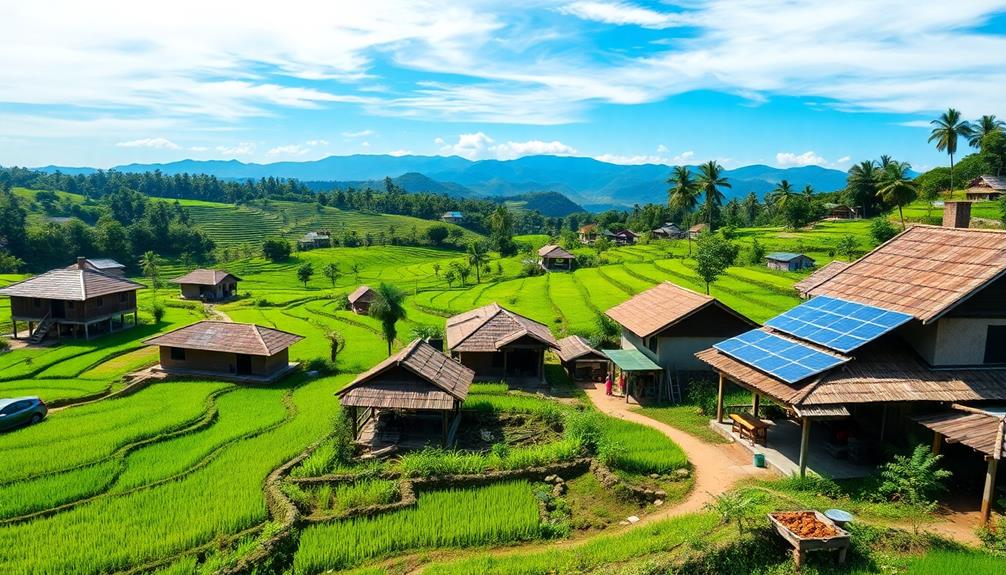
Sabrang Village stands out as a vibrant example of sustainable rural design in Indonesia, where local farmers cultivate rice varieties like Rojolele and Mentik Wangi, producing an impressive 20,395 tons annually.
This thriving community emphasizes sustainable development through identity-making and the integration of local culture into its initiatives. By involving community members as co-designers, Sabrang fosters participatory design that promotes local narratives and collective decision-making.
The emphasis on natural materials and traditional craftsmanship resonates with Balinese design characteristics, enriching the village's identity and sense of place. Traditional ecological knowledge, especially practices like Niteni and Pranatamangsa, plays an essential role in guiding sustainable agricultural practices and preserving local wisdom.
You'll notice how these practices enhance the village's agricultural activities while also reinforcing community bonds. The integration of Japanese design principles further enriches Sabrang's approach, emphasizing bi-directional learning that enhances craftsmanship and community involvement.
This holistic approach not only strengthens Sabrang's economic activities but also highlights its tourism potential. Visitors are drawn to the village's unique blend of tradition and innovation, making it a model for other rural areas aiming for sustainable growth.
In Sabrang, community involvement and respect for local culture create a blueprint for sustainable rural development that other regions can aspire to replicate.
Frequently Asked Questions
What Are the Main Challenges to Sustainable Rural Design in Indonesia?
You'll face challenges like limited resources, inadequate infrastructure, and diverse cultural practices. Balancing economic growth with environmental sustainability is tough, too. Engaging the community and fostering collaboration can help overcome these hurdles effectively.
How Can Technology Support Sustainable Rural Development Efforts?
When it comes to sustainable rural development, technology's your best friend. You can leverage data analytics, renewable energy, and smart agriculture tools to enhance efficiency, reduce waste, and ultimately create a thriving, eco-friendly community.
What Role Do Government Policies Play in Rural Sustainability?
Government policies shape rural sustainability by providing frameworks for funding, resources, and regulations. You'll find that effective policies encourage community engagement, promote eco-friendly practices, and support infrastructure development, driving long-term benefits for rural areas.
How Do Local Cultures Influence Sustainable Design Practices?
Local cultures shape sustainable design practices by embedding traditional knowledge and values into modern approaches. You'll find that community involvement, local materials, and unique customs drive innovative solutions that respect the environment and enhance livability.
What Funding Sources Are Available for Sustainable Rural Projects?
To fund sustainable rural projects, you might explore grants from organizations like the Global Environment Facility. These funds could help implement a community solar initiative, enhancing energy access while promoting eco-friendly practices in your area.
Conclusion
As you explore sustainable rural design trends in Indonesia, you'll find that 80% of the population still lives in rural areas, highlighting the importance of innovative practices. By embracing participatory design and traditional ecological knowledge, communities can thrive amidst industrial pressures. Engaging with locals not only fosters social cohesion but also leads to solutions tailored to their unique contexts. The case of Sabrang Village exemplifies how these approaches can create resilient and vibrant rural spaces for future generations.
-

 Vetted4 months ago
Vetted4 months ago14 Best Personalized Father's Day Gifts for Your Husband – Show Him You Care
-

 Alfresco4 months ago
Alfresco4 months agoAlfresco Stacker Doors: Seamless Indoor-Outdoor Living!
-

 Vetted5 months ago
Vetted5 months ago15 Best EMS Foot Massagers for Neuropathy to Soothe Your Feet
-

 Craft and Textiles6 months ago
Craft and Textiles6 months ago15 Best Places to Buy Appliances for Your Home – Top Retailers Reviewed
-

 Craft and Textiles6 months ago
Craft and Textiles6 months ago15 Best Gifts for 4-Year-Old Girls That Will Spark Joy and Creativity
-

 Craft and Textiles6 months ago
Craft and Textiles6 months ago15 Best Battery-Powered Leaf Blowers for Effortless Yard Work
-

 Craft and Textiles6 months ago
Craft and Textiles6 months ago15 Best Cordless Mowers for Effortless Lawn Care – Top Picks of 2024
-

 Decorative Throws6 months ago
Decorative Throws6 months agoIs It Better to Dry Clean Blankets?





























